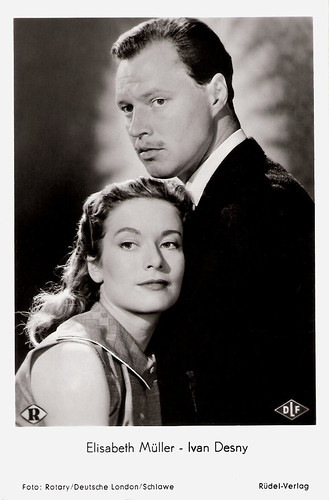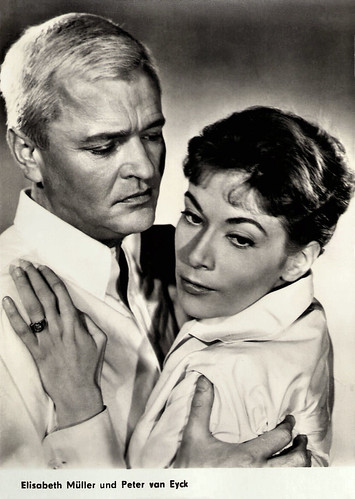Swiss actress Elisabeth Müller (1926-2006) was a popular star of the German Cinema in the 1950s. Her popularity brought her to Hollywood where she appeared in a few films.
![Elisabeth Müller in Moselfahrt aus Liebeskümmer (1953)]()
German postcard by Kunst und Bild, Berlin, no. A 1107. Photo: Joe Niczky / Ariston / Columbia. Publicity still for Moselfahrt aus Liebeskümmer/Heartbroken on the Moselle (Kurt Hoffmann, 1953).
![Elisabeth Müller in Moselfahrt aus Liebeskümmer (1953)]()
East-German postcard by VEB Progress Film-Vertrieb, Berlin, no. 238. Photo: Ariston-Film. Publicity still for Moselfahrt aus Liebeskümmer/Heartbroken on the Moselle (Kurt Hoffmann, 1953).
![Elisabeth Müller and Will Quadflieg in Moselfahrt aus Liebeskummer (1953)]()
East-German postcard by Progress, Berlin, no. 242, 1956. Photo: Ariston-Film. Publicity still for Moselfahrt aus Liebeskümmer/Heartbroken on the Moselle (Kurt Hoffmann, 1953) with Will Quadflieg.
![Elisabeth Müller and Ivan Desny in André und Ursula (1955)]()
German postcard by Rüdel-Verlag, Hamburg-Bergedorf, no. 1364. Photo: Rotary / Deutsche London / Schlawe. Publicity still for André und Ursula/Andre and Ursula (Werner Jacobs, 1955) with Ivan Desny.
![Elisabeth Müller and Robert Taylor in The Power and the Prize (1956)]()
German postcard by Kolibri-Verlag G.m.b.H., Minden/Westf, no. 2819. Photo: Metro-Goldwyn-Mayer. Publicity still for The Power and the Prize (Henry Koster, 1956) with Robert Taylor.
Elisabeth Müller was born in Basel, Switzerland in 1926.
She studied acting with her aunt, stage actress Ellen Widmann, and between 1944 and 1946 she followed classes at the Schauspielschule Zürich. The next years she worked in many Swiss and German theatre companies.
As Lisabet Müller, she made her film debut in Paragraph 51 – Seelenarzt Dr. Laduner/Paragraph 51 - Headshrinker Dr. Laduner (Leopold Lindtberg, 1947). Another popular Swiss film with her was the crime film Matto regiert/Madness Rules (Leopold Lindtberg, 1947).
In Germany, she played in the comedy Der Tag vor der Hochzeit/The Day before the Wedding (Rolf Thiele, 1952) opposite Paul Dahlke and Joachim Brennecke.
Her first big hit, the sentimental romance Moselfahrt aus Liebeskummer/Heartbroken on the Moselle
(Kurt Hoffmann, 1953) with Will Quadflieg, made her a darling of the cinema public in the 1950s.
Next she worked twice with the legendary director G.W. Pabst, for the crime drama Das Bekenntnis der Ina Kahr/Afraid to Love (Georg Wilhelm Pabst, 1954) with Curd Jürgens, and for the drama Rosen für Bettina/Ballerina (Georg Wilhelm Pabst, 1956) opposite Willy Birgel.
![Elisabeth Müller]()
German postcard by Kunst und Bild, Berlin, no. A 1218. Photo: NF / Lilo / Ariston GmbH. Publicity still for Morgengrauen/Dawn (Viktor Tourjansky, 1954).
![Elisabeth Müller in Rosen für Bettina (1955)]()
German postcard by WS-Druck, Wanne-Eickel. Photo: Carlton / NF / Michaelis. Publicity still for Rosen für Bettina/Ballerina (G.W. Pabst, 1955).
![Elisabeth Müller]()
German postcard by Universum-Film Aktiengesellschaft, Berlin-Tempelhof, no. FK 3488. Retail price: 25 Pfg. Photo: Maack / Arca-NF-Film. Publicity still for Geliebte Corinna/Beloved Corinna (Eduard von Borsody, 1956).
![Elisabeth Müller in Geliebte Corinna (1956)]()
German postcard by Universum-Film Aktiengesellschaft, Berlin-Tempelhof, no. FK 3489. Retail price: 25 Pfg. Photo: Arthur Grimm / Arca-NF-Film. Publicity still for Geliebte Corinna/Beloved Corinna (Eduard von Borsody, 1956).
![Elisabeth Müller in Skandal in Ischi (1957)]()
German postcard by Kunst und Bild, Berlin-Charlottenburg, no. T 871. Photo: Vienna / Schorcht / Hämmerer. Publicity still for Skandal in Ischi/Scandal in Bad Ischl (Rolf Thiele, 1957).
Her popularity brought Elisabeth Müller to Hollywood where she appeared in The Power and the Prize (Henry Koster, 1956), costarring with Robert Taylor, and the war drama The Angry Hills (Robert Aldrich, 1957-1959) with Robert Mitchum and based on a novel by Leon Uris. Neither film was a commercial success.
She returned to Europe where she appeared in such films as Taxichauffeur Bänz/Taxi Driver Bänz (Werner Düggelin, Hermann Haller, 1957) with Maximilian Schell in one of his first roles, and El Hakim (Rolf Thiele, 1957) with O.W. Fischer.
Her biggest TV success was the Mini-series Am grünen Strand der Spree/At the Green Beach of the River Spree (Fritz Umgelter, 1960) with Peter Pasetti, based on a novel by Hans Scholz.
Since the early 1960s, she worked mainly in the theatre, but in the 1960s and in the 1980s she also occasionally was seen in TV films like Ottiliens Tollheiten/Ottilien's Follies (Ludwig Berger, 1964) and Die Tote im Schlosspark/The Body in Schlosspark (Jürgen Goslar, 1984).
At the age of 80, Elisabeth Müller passed away in 2006 in Sempach, Switzerland. She was married to director and director of photography Kurt Grigoleit.
![Elisabeth Müller and Peter van Eyck in Dr. Crippen lebt (1958)]()
East-German postcard by VEB Progress Film-Vertrieb, Berlin, no. 1534, 1961. Retail price: 0,20 DM. Photo: publicity still for Dr. Crippen lebt/Doctor Crippen lives (Erich Engels, 1958) with Peter van Eyck.
![Peter van Eyck, Elisabeth Müller]()
East-German postcard by VEB Progress Film-Vertrieb, Berlin, no. 1535, 1961. Retail price: 0,20 DM. Photo: publicity still for Dr. Crippen lebt/Doctor Crippen lives (Erich Engels, 1958) with Peter van Eyck.
![Elisabeth Müller]()
German postcard by WS-Druck, Wanne-Eickel, no. F 41. Photo: Klaus Collignon.
![Elisabeth Müller]()
German postcard by WS-Druck, Wanne-Eickel, no. F 114. Photo: Klaus Collignon.
![Elisabeth Müller]()
Belgian postcard by Cox, no. 12.
Sources: Wikipedia (German) and IMDb.

German postcard by Kunst und Bild, Berlin, no. A 1107. Photo: Joe Niczky / Ariston / Columbia. Publicity still for Moselfahrt aus Liebeskümmer/Heartbroken on the Moselle (Kurt Hoffmann, 1953).

East-German postcard by VEB Progress Film-Vertrieb, Berlin, no. 238. Photo: Ariston-Film. Publicity still for Moselfahrt aus Liebeskümmer/Heartbroken on the Moselle (Kurt Hoffmann, 1953).

East-German postcard by Progress, Berlin, no. 242, 1956. Photo: Ariston-Film. Publicity still for Moselfahrt aus Liebeskümmer/Heartbroken on the Moselle (Kurt Hoffmann, 1953) with Will Quadflieg.

German postcard by Rüdel-Verlag, Hamburg-Bergedorf, no. 1364. Photo: Rotary / Deutsche London / Schlawe. Publicity still for André und Ursula/Andre and Ursula (Werner Jacobs, 1955) with Ivan Desny.

German postcard by Kolibri-Verlag G.m.b.H., Minden/Westf, no. 2819. Photo: Metro-Goldwyn-Mayer. Publicity still for The Power and the Prize (Henry Koster, 1956) with Robert Taylor.
A Darling of the Cinema Public
Elisabeth Müller was born in Basel, Switzerland in 1926.
She studied acting with her aunt, stage actress Ellen Widmann, and between 1944 and 1946 she followed classes at the Schauspielschule Zürich. The next years she worked in many Swiss and German theatre companies.
As Lisabet Müller, she made her film debut in Paragraph 51 – Seelenarzt Dr. Laduner/Paragraph 51 - Headshrinker Dr. Laduner (Leopold Lindtberg, 1947). Another popular Swiss film with her was the crime film Matto regiert/Madness Rules (Leopold Lindtberg, 1947).
In Germany, she played in the comedy Der Tag vor der Hochzeit/The Day before the Wedding (Rolf Thiele, 1952) opposite Paul Dahlke and Joachim Brennecke.
Her first big hit, the sentimental romance Moselfahrt aus Liebeskummer/Heartbroken on the Moselle
(Kurt Hoffmann, 1953) with Will Quadflieg, made her a darling of the cinema public in the 1950s.
Next she worked twice with the legendary director G.W. Pabst, for the crime drama Das Bekenntnis der Ina Kahr/Afraid to Love (Georg Wilhelm Pabst, 1954) with Curd Jürgens, and for the drama Rosen für Bettina/Ballerina (Georg Wilhelm Pabst, 1956) opposite Willy Birgel.

German postcard by Kunst und Bild, Berlin, no. A 1218. Photo: NF / Lilo / Ariston GmbH. Publicity still for Morgengrauen/Dawn (Viktor Tourjansky, 1954).

German postcard by WS-Druck, Wanne-Eickel. Photo: Carlton / NF / Michaelis. Publicity still for Rosen für Bettina/Ballerina (G.W. Pabst, 1955).

German postcard by Universum-Film Aktiengesellschaft, Berlin-Tempelhof, no. FK 3488. Retail price: 25 Pfg. Photo: Maack / Arca-NF-Film. Publicity still for Geliebte Corinna/Beloved Corinna (Eduard von Borsody, 1956).

German postcard by Universum-Film Aktiengesellschaft, Berlin-Tempelhof, no. FK 3489. Retail price: 25 Pfg. Photo: Arthur Grimm / Arca-NF-Film. Publicity still for Geliebte Corinna/Beloved Corinna (Eduard von Borsody, 1956).

German postcard by Kunst und Bild, Berlin-Charlottenburg, no. T 871. Photo: Vienna / Schorcht / Hämmerer. Publicity still for Skandal in Ischi/Scandal in Bad Ischl (Rolf Thiele, 1957).
Hollywood
Her popularity brought Elisabeth Müller to Hollywood where she appeared in The Power and the Prize (Henry Koster, 1956), costarring with Robert Taylor, and the war drama The Angry Hills (Robert Aldrich, 1957-1959) with Robert Mitchum and based on a novel by Leon Uris. Neither film was a commercial success.
She returned to Europe where she appeared in such films as Taxichauffeur Bänz/Taxi Driver Bänz (Werner Düggelin, Hermann Haller, 1957) with Maximilian Schell in one of his first roles, and El Hakim (Rolf Thiele, 1957) with O.W. Fischer.
Her biggest TV success was the Mini-series Am grünen Strand der Spree/At the Green Beach of the River Spree (Fritz Umgelter, 1960) with Peter Pasetti, based on a novel by Hans Scholz.
Since the early 1960s, she worked mainly in the theatre, but in the 1960s and in the 1980s she also occasionally was seen in TV films like Ottiliens Tollheiten/Ottilien's Follies (Ludwig Berger, 1964) and Die Tote im Schlosspark/The Body in Schlosspark (Jürgen Goslar, 1984).
At the age of 80, Elisabeth Müller passed away in 2006 in Sempach, Switzerland. She was married to director and director of photography Kurt Grigoleit.

East-German postcard by VEB Progress Film-Vertrieb, Berlin, no. 1534, 1961. Retail price: 0,20 DM. Photo: publicity still for Dr. Crippen lebt/Doctor Crippen lives (Erich Engels, 1958) with Peter van Eyck.

East-German postcard by VEB Progress Film-Vertrieb, Berlin, no. 1535, 1961. Retail price: 0,20 DM. Photo: publicity still for Dr. Crippen lebt/Doctor Crippen lives (Erich Engels, 1958) with Peter van Eyck.

German postcard by WS-Druck, Wanne-Eickel, no. F 41. Photo: Klaus Collignon.

German postcard by WS-Druck, Wanne-Eickel, no. F 114. Photo: Klaus Collignon.

Belgian postcard by Cox, no. 12.
Sources: Wikipedia (German) and IMDb.